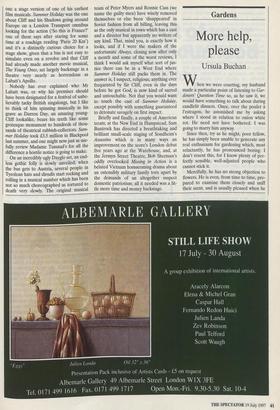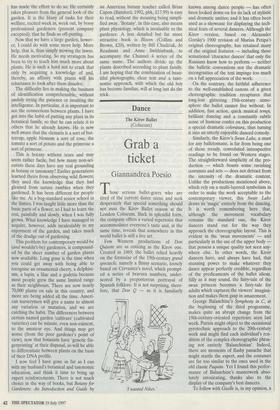Gardens
More help, please
Ursula Buchan
When we were courting, my husband made a particular point of listening to Gar- deners' Question Time so, as he saw it, we would have something to talk about during candlelit dinners. Once, over the poulet a l'estragon, he astonished me by asking where I stood in relation to onion white rot. He need not have bothered. I was going to many him anyway.
Since then, try as he might, poor fellow, he has simply been unable to generate any real enthusiasm for gardening which, most reluctantly, he has pronounced boring. I don't resent this, for I know plenty of per- fectly sensible, well-adjusted people who cannot stick it.
Mercifully, he has no strong objection to flowers. He is even, from time to time, pre- pared to examine them closely and sniff their scent, and is usually pleased when he has made the effort to do so. He certainly takes pleasure from the general look of the garden. It is the litany of tasks for their welfare, recited week in, week out, by bossy professional gardeners (present company excepted), that he finds so off-putting.
Now that we have a large garden, howev- er, I could do with some more help. More help, that is, than simply mowing the lawns. He needs motivating. So my stratagem has been to try to teach him much more about plants. He is such a hard nut to crack that only by acquiring a knowledge of and, thereby, an affinity with plants will his reluctance to look after them dissolve.
The difficulty lies in making the business of identification comprehensible, without unduly trying the patience or insulting the intelligence. In particular, it is important to see the connections between plants. I have got into the habit of putting any plant in its botanical family, so that he can relate it to others that he already knows. He is now well aware that the clematis is a sort of but- tercup, apple blossom a sort of rose, the tomato a sort of potato and the primrose a sort of primrose.
This is botany without tears and may seem rather facile, but how many non-sci- entists these days have any real grounding in botany or taxonomy? Earlier generations learned theirs from observing wild flowers; they used the knowledge that they had gleaned from nature rambles when they gardened. It has been different for people like me. At a bog-standard senior school in the Sixties, I was taught little more than the basic parts of a flower, so I had to learn the rest, painfully and slowly, when I was fully grown. What knowledge I have managed to acquire, however, adds incalculably to my enjoyment of the garden, and takes much of the drudge out of gardening.
This problem for contemporary would-be (and wouldn't-be) gardeners, is compound- ed by the sheer number of garden plants now available. Long gone is the time when you could get away with being able to recognise an ornamental cherry, a delphini- um, a lupin, a lilac and a godetia because most people grew the same limited range as their neighbours. There are now nearly 70,000 plants on sale in this country, and more are being added all the time. Ameri- can nurserymen will give a name to almost any variation or mutation, and we are catching the habit. The differences between certain named garden `cultivars' (cultivated varieties) can be minute, even non-existent, to the amateur eye. And things may get worse (from the poor gardener's point of view), now that botanists have 'genetic fin- gerprinting' at their disposal, so will be able to differentiate between plants on the basis of their DNA profile.
I now feel I have gone as far as I can with my husband's botanical and taxonomic education, and think it time to bring up expert reinforcements. There is not much choice in the way of books, but Botany for Gardeners: An Introduction and Guide by an American botany teacher called Brian Capon (Batsford, 1992, pbk, £17.99) is easy to read, without the meaning being simpli- fied away. 'Botany', in this case, also means plant physiology, which is invaluable to the gardener. A less detailed but far more attractive book is Bloom (Collins and Brown, £20), written by Bill Chudziak, Jo Readman and Anne Swithinbank, to accompany the Channel 4 series of the same name. The authors divide up the plants described according to plant family. I am hoping that the combination of beau- tiful photographs, clear text and a taxo- nomic approach, with which the old boy has become familiar, will at long last do the trick.



























































 Previous page
Previous page